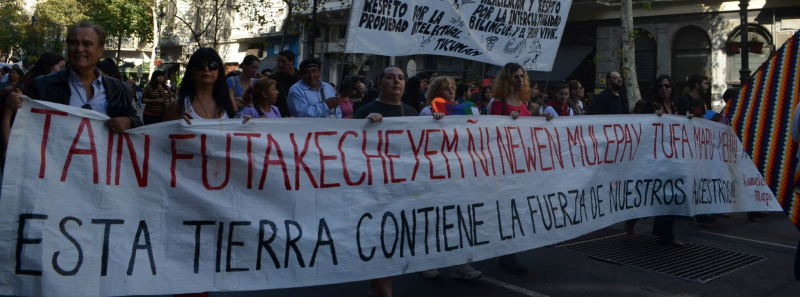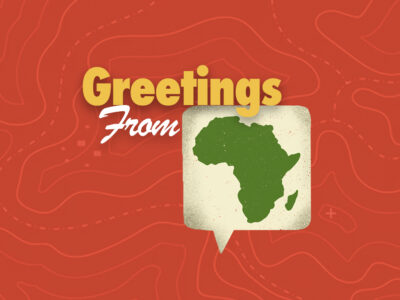
This is the second article part of the project “Müpüley Tain mapudungun” (Our Mapudungun Soaring), a recipient of a 2015 Microgrant to support initiatives of Indigenous Language Digital Activism. This project is carried out in the city of Buenos Aires, Argentina, and seeks to strengthen the Mapudungun language through the link between political and cultural revival of the urban Mapuches and learning the tools of the radio art.
by Simona Mayo and Francisco Godinez*
The cities speak. Through conversations, signs, radios, street names and people; through the sounds of car brakes and horns. They also speak in different languages, which have been coming to them and intertwining with each other. Located North of the historical Mapuche territory, Buenos Aires also speaks Mapudungun and there are various initiatives to revitalize this language in the city. In this article, Simona Mayo and Francisco Godinez, members of the Müpüley taiñ mapudungun initiative, talk about the situation of the Mapuche language in Argentina's capital, and the importance of its revitalization by collecting the Mapuche sounds of the city through the radio art.
According to the Argentinian government statistics, 10,000 Mapuches live in Buenos Aires, and of those, 1,700 speak or understand the Mapudungun language. Although we question these figures, at least we have a basis to research on what is the vitality of the Mapuche language today in Buenos Aires and in the historical territory Puelmapu in general, and on what can we do to revitalize the language.
When we talk about the linguistic vitality of a language we refer to the actual use of it or of a specific linguistic variety that a community of speakers performs. The linguistic vitality of the Mapudungun language does not show, in this case, only in numbers, how many people speak it and where geographically, but it also makes us aware of various dynamics, applications and new uses in specific, traditional or contemporary contexts. These linguistic-cultural dynamics, as nütramkan (everyday conversations), the üllkantun (song), the story of epew (tales), Mapuche hip-hop, among others, reflect how people have chosen to speak their language, maintain expressions and usages, and, above all, revitalize it. Many of these practices are found in large cities where the Mapuches migrated in Argentina.
One of the great features of modern languages is their ability to create and their capacity to change and not change at the same time. First, the Mapudungun language has been strengthened linguistically and culturally because its tradition has been maintained in the longko (heads) of an entire generation. Second, the Mapuche language has been sustained because it has allowed new generations to renew it, always preserving its cultural heritage.
Challenges and strategies of the Mapudungun language
Currently, Mapudungun is in a critical situation, because it is at a crossroads of two possible directions. One of them, announced by many linguists, is that, despite its current bilingualism, it is in the process of displacement, that is, when the older generation of speakers are dissappearing, the language will be completely lost.
The second route is that taken by the younger generations, daughters and granddaughters of forced migration from the Wallmapu (Mapuche territory) and of the disintegration of the Mapuche social fabric, a result of the colonization campaigns. This recognizes the previous diagnosis, however, it raises the reversal of displacement through language revitalization and restructuring of intergenerational transmission circuits. This second path appeals to the recognition, valuation and learning from the older generation of speakers, who have maintained the language, despite the difficulties encountered throughout history, as a mechanism of action.
The latter Rüpü (path), which is currently being strongly built, affirmed and consolidated in the Kimün (knowledge) of füchakeche (old) and newen de wechekeche (young). A language that is not updated, that fails to represent the surrounding world as this is changing, is a language in danger of disappearing. It is not the case of the Mapuche language. The new speakers, young people who today lead the revitalization of the Mapuche language, not only have been responsible that Mapudungun recovers functional speech spaces, but they have also created new instances for its development and maintenance.
Organizations such as the Mapuche Student Federation (FEMAE) and the Wallmapuwen party, groups of Mapuche education as Kom kim mapudunguaiñ waria mew in Santiago de Chile or Wixaleyiñ in Buenos Aires, and kimelfe (teachers) with extensive teaching experience, have currently achieved to position the language in society as a whole, Mapuche and non-Mapuche, through the breakdown of the old prejudices which were attributed to the language.
Thus, today, the motivations to strengthen the teaching and revitalization of Mapudungun arise from the depths of the Mapuche social fabric. In the case of the revitalization work being done in the city of Buenos Aires, it is possible to see an urgent need to make the language visible while teaching it. The city of Buenos Aires is a city built under a European tradition that has hidden, deleted, and repressed the indigenous heritage of the territory. Taking this into consideration, these organizations aim to affirm the presence of a preexisting village, to account for the richness of its language and culture, and to break down the racist prejudices about the Mapuche people.
The Mapuches in Buenos Aires: the search for new and old sounds
The only available data on the number of the Mapuche population residing in Buenos Aires come from the Complementary Survey of Indigenous Peoples (2004-2005) which estimates that there are 9,750 Mapuche inhabitants in the capital of Argentina. This figure shows a strong underrepresentation; in fact, after the poll, many indigenous organizations indicated that this survey committed a “statistical ethnocide”. However, these are the official figures.
In regards to the Mapudungun speakers at the country level, the survey accounted for 17.3% of people who speak or understand the language, 2.2% of which speak it regularly, and 3.6% speak it and recognize it as their mother tongue. It is also relevant to note that out of the total Mapuche population, 93.3% do not receive education in the Mapudungun language.
The production and design of new tools for teaching and dissemination of the language aim to change these statistics. In this regard, it should be noted the work for the revitalization of the Mapudungun language done by groups such as the Wixaleyiñ which publishes texts and organizes teaching workshops, as well as numerous other kimelfe (teachers) that in recent years have been dedicated to this task in various spaces such as universities, unions and assemblies.
It is in this direction that our Müpüley Tain mapudungun initiative works for the language revitalization through the tools of radio art. We believe that the audio documentary is a genre which has a fundamental contribution to the recovery of the oral tradition, which exists because we are beings who communicate with sounds. The human being is able to communicate in sophisticated ways because of its language and reasoning ability. The human beings can not exist without a community, without exercising their rational, emotional and linguistic abilities; in short, communicating with the other. And communication is, above all, sound. The sound that speaks to reason, but also to the emotion. The sound is both concepts and sensations.
The audio documentary is a hybrid genre between journalism and art. It is a flexible and broad radio genre used to talk about stories and issues of the world, with a strong emphasis on sound as a narrative value. The sound narrates: a voice does not only account for what it is said, but also how it is said. A language is not just words, but intonations, inflections, silences, expressions; sounds that create a world. This world sometimes can only be described through those sounds and not others.
The audio documentary is the ideal genre for narrating about the culture, identity, language, and art of a people, which themselves are the protagonists, with their sounds and forms of expression, without the mediation of a journalist or of an authoritative voice. First, culture is narrated back to the same people, who achieve self-identification and reaffirmation based on the familiarity, intimacy and closeness of sounds. And second, to the rest of society, which can discover and understand this culture embedded and mixed with their own culture.
The genre combines testimonies, audio recordings, soundscapes, interviews, radio art, fiction, music; also, commentary on the aesthetic choices. In short, it uses the radio language to create a meaningful and attractive collage. It makes people see with their ears; it shows space and time as related, and the most characteristic aspects of the fundamental elements of a culture such as language, poetry and music. It is as fundamental as sound.
This is the path we are taking through this initiative, with very concrete and specific goals such as the production of three audio documentaries, but embedded in a much larger effort to revitalize the language. We believe this represents the beginning of a response to the questions posed at the start of this article.
*Members of the Müpüley taiñ mapudungun initative. Contact us: simonna.mayo@gmail.com and francisco@cpr.org.ar


